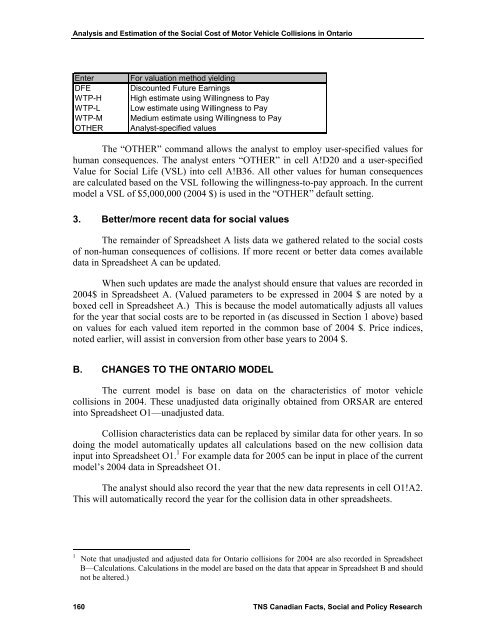Keith Vodden Dr. Douglas Smith - Transports Canada
Keith Vodden Dr. Douglas Smith - Transports Canada
Keith Vodden Dr. Douglas Smith - Transports Canada
Create successful ePaper yourself
Turn your PDF publications into a flip-book with our unique Google optimized e-Paper software.
Analysis and Estimation of the Social Cost of Motor Vehicle Collisions in Ontario<br />
Enter<br />
DFE<br />
WTP-H<br />
WTP-L<br />
WTP-M<br />
OTHER<br />
For valuation method yielding<br />
Discounted Future Earnings<br />
High estimate using Willingness to Pay<br />
Low estimate using Willingness to Pay<br />
Medium estimate using Willingness to Pay<br />
Analyst-specified values<br />
The “OTHER” command allows the analyst to employ user-specified values for<br />
human consequences. The analyst enters “OTHER” in cell A!D20 and a user-specified<br />
Value for Social Life (VSL) into cell A!B36. All other values for human consequences<br />
are calculated based on the VSL following the willingness-to-pay approach. In the current<br />
model a VSL of $5,000,000 (2004 $) is used in the “OTHER” default setting.<br />
3. Better/more recent data for social values<br />
The remainder of Spreadsheet A lists data we gathered related to the social costs<br />
of non-human consequences of collisions. If more recent or better data comes available<br />
data in Spreadsheet A can be updated.<br />
When such updates are made the analyst should ensure that values are recorded in<br />
2004$ in Spreadsheet A. (Valued parameters to be expressed in 2004 $ are noted by a<br />
boxed cell in Spreadsheet A.) This is because the model automatically adjusts all values<br />
for the year that social costs are to be reported in (as discussed in Section 1 above) based<br />
on values for each valued item reported in the common base of 2004 $. Price indices,<br />
noted earlier, will assist in conversion from other base years to 2004 $.<br />
B. CHANGES TO THE ONTARIO MODEL<br />
The current model is base on data on the characteristics of motor vehicle<br />
collisions in 2004. These unadjusted data originally obtained from ORSAR are entered<br />
into Spreadsheet O1—unadjusted data.<br />
Collision characteristics data can be replaced by similar data for other years. In so<br />
doing the model automatically updates all calculations based on the new collision data<br />
input into Spreadsheet O1. 1 For example data for 2005 can be input in place of the current<br />
model’s 2004 data in Spreadsheet O1.<br />
The analyst should also record the year that the new data represents in cell O1!A2.<br />
This will automatically record the year for the collision data in other spreadsheets.<br />
1<br />
Note that unadjusted and adjusted data for Ontario collisions for 2004 are also recorded in Spreadsheet<br />
B—Calculations. Calculations in the model are based on the data that appear in Spreadsheet B and should<br />
not be altered.)<br />
160 TNS Canadian Facts, Social and Policy Research
















